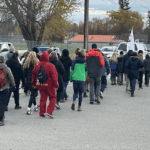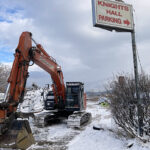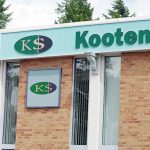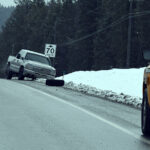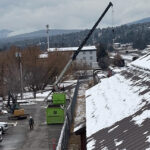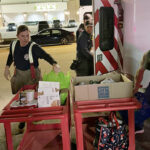Home »

Sullivan Mine lives on with Kimberley Underground Mining Railroad
There is a tiny trickle of activity today compared to a continuous surge in its heyday, but the Sullivan Mine lives on thanks to the Kimberley Underground Mining Railway (KUMR).
That tiny trickle is actually a clattering, shaking and highly educational and entertaining coal mine shuttle train and tour made available on a daily basis during the busy summer season.
Owned and operated by the Sullivan Mine and Railway Historical Society, the mine tour and train ride has been available to the public for 28 years and is now one of the most outstanding half-day tourist attractions in the region.
This summer it was even restored to a former level of service, once again returning riders to the Kimberley Alpine Resort, running from the KUMR’s station adjacent to downtown Kimberley.
At the station area, visitors can tour the Orpheum Theatre, the North Star Schoolhouse, the Miner’s Cabin and the Caboose before embarking on a purposely bumpy ride beside and over Mark Creek and up and into a section of the once massive mine.
“Learn about life as a miner at the Underground Interpretive Centre as our miner guide will describe hard rock mining and demonstrate some of the equipment used in the Sullivan Mine. Join us for a short walk to the Sullivan Mine Powerhouse for a guided tour featuring the huge compressors and generators that powered the mine. Board the train again to learn more about Kimberley and enjoy spectacular scenery and glimpses of the occasional wild life as you travel back to the station,” the KUMR’s website exhorts.
The rail ride is left bumpy, guides explain, to give visitors a sense of what miners experienced on their way and out of what was once one of the world’s most productive mines.
While gold was all the rage in the East Kootenay, beginning with the first strikes in the early 1860s, and coal mining was king to the east in the Rockies, a different form of emerging ore wealth was discovered at the Sullivan Mine site in 1892 – lead, zinc and silver.
By 1909 the mine was in production, run by the Consolidated Mining and Smelting Company of Canada, then-owned by the Canadian Pacific Railway, purchased the property. That company later became Cominco Ltd. and then Teck Cominco, which owned the mine until it closed in 2001.
During its 92 years of production, the Sullivan Mine produced ore with more than 17 million tons of zinc and lead and more than 285 million (troy) ounces of silver, all valued at more than $20 billion. Interestingly, Kodak purchased all the silver produced in the mine for film production.
During its run, the Sullivan employed, on average, 1,000 workers, who made on average $68,000 a year each, with roughly $5 billion in wages paid out over its lifetime. During the Second World War the mine had 2,000 employees and in 2001, there were 340. But they were producing as much as 2,000 because of advances in mining technology perfected by Teck.
“Taxes, payments to suppliers and the purchase of local and provincial services, along with smelting and refining of concentrates in Trail, B.C., have constituted a good part of the mine’s $20-billion direct contribution to the local and provincial economies,” noted Douglas Horswill in the Nov. 5, 2001 issue of The Northern Miner.
“Beyond the direct contribution, economists often refer to the indirect effects of a major resource industry; these include economic contributions to the local retail industry, purchases of services, housing, education, and so on. This would amount to three times the direct contribution or another $60 billion in total gross provincial added to the provincial economy from Sullivan over its long and illustrious life,” he wrote.
Following its long-expected closure in 2001, the Sullivan Mine has remained an important property with Teck Cominco, which continues a lengthy and expensive reclamation and decommissioning program.
“Today, Teck Cominco designs mines for closure in order to minimize the environmental consequences and the cost of reclamation. This was not the case in the early part of this century. However, the company recognizes its responsibility in ensuring that Sullivan is environmentally safe and will spend in the order of $70 million toward that end,” stated Horswill, a former senior vice-president of environment and corporate affairs for Teck Cominco.
The logistics and facts of the Sullivan Mine are mind-boggling to consider.
At its height, the mine had 10 miles (16 km) of roads and 60 miles (100 km) of rail lines, with up to 100 electric train engines working within. In total there is 300 miles of tunnel in the mountain.
“God, it was never dull” working at the mine, recalled KUMR senior tour guide and 36-year mine employee W.R. (Bill) Roberts (pictured at top and in the photo show).
Roberts provides fabulous colour to the mine tour, once visitors enter the “drift,” the name of a rail tunnel in the mine. After entering the drift, following a slow, curving climb uphill on the small gauge rail, guests disembark and are met by Roberts, a rugged, gravelly voiced gent who is serious about his former business, which makes the tour so much more authentic and appealing.
He outlines the dangers, challenges and expectations put on the miners who ventured out of sunlight or moonlight each shift.
“If you walk into a shaft, you only walk in once,” he candidly tells people with just enough humour in his voice, while showing different aspects of mining, from a scoop to blasting to drilling.
He hoists a 136 pound drill and informs guests, “if you can’t lift it up and run you’re going to have to find another way to make a living.”
Roberts’ love of mining is evident as he speaks, and it’s evident in print, too. He is the best-selling author of The Best Miners in the World, a tome on the Sullivan Mine that is in its third printing.
“It’s a legacy to the miners,” he said, noting that the Sullivan Mine was one of the safer operations going but 73 miners still lost their lives in it during its 92 year run.
While dangerous and tough, working in the mine was also thrilling, he said.
“If I had a good partner and a cross shift, I’d make more money than a professional. The further we went in, the more we’d earn but it’s not a job for everyone. It was very demanding,” Roberts said, while explaining a drilling pattern and how miners blasted away rock. “I can drill holes and blow things up real good,” he added.
If a miner didn’t drill and load explosives correctly, it would severely hamper their ability to earn, he explained.
“There’d be a lot of smoke, a lot of stink and a lot of getting’ nothing done. You gotta think politicians, uh?” He cracked.
Following the mining demonstrations, Roberts leads his party into a ‘refuge station,’ a site built to serve as a safety area in case of poisonous air, fire, floods or other threats to miners’ lives.
If miners smelled “rotten eggs” they had to beat a hasty retreat to a refuge area, even though the mine featured ample air supply, provided by the old powerhouse, which is the final stop on the tour.
“We had a lot of air,” Roberts said, explaining there were two 12 inch lines running into it, fed by the powerhouse. The refuge stations had four foot airlocks to seal the rooms and extra efforts were taken by those inside to seal them further.
“You could stay in here indefinitely,” he told the tour, making one stop to ponder what it would have been like to be stuck in such a small chamber with numerous hard-working miners, not knowing how long they’d be stuck in there. To preserve light, they’d burn one lamp at a time.
“It never got to that point here. We were very lucky,” Roberts said, recalling one incident when a part of the mine flooded with a flash of seven million gallons of water.
“Everyone was hanging on until it went by,” he said matter-of-factly.
The longest he recalled having to stay in a refuge station was four hours. “Just enough time to catch up and play a few games of crib.”
Following Roberts’ portion of the ‘drift’ tour, guests re-board the train and clatter their way back downhill to the powerhouse, where they are met by a differently clad Roberts, free from his mining duds.
“It was pretty active here at one time,” he says in the cavernous space filled with massive steel machinery.
“What I really like is when Teck Cominco shut down in 2001 they didn’t sell all this for scrap. They could have made a lot of money. But you don’t sell your history or your heritage,” Roberts tells the tour group.
It is fortunate to have such a well-versed and experienced guide – someone who was more than just hands on at the mine; someone who lived a large portion of his life beneath the mountain that built Kimberley.
Roberts notes that he isn’t alone, pointing out that there are many retired mine and Teck employees who help out with the Sullivan Mine and Railway Historical Society.
Concluding the tour, guests learn about the ongoing reclamation efforts of Teck, which has thus far spent $26 million.
“And they’ve done a pretty good job,” Roberts offers, noting there was even an unexpected setback. After 100,000 trees had been planted around the sloping property, a herd of 400 elk moved in and pretty much devoured them all.
“They thought it was a buffet,” Roberts chuckled.
“We’ve got a nice pack of wolves up there now, which is really good,” he added.
Once a mine is decommissioned, it doesn’t mean that it can be ignored, Roberts told the tour.
A reclamation plant by the St. Mary River continues to clean water coming out of the mine.
“There is going to be someone looking after this mine until the end of time,” Roberts said. “You can’t walk away” from a mine anymore in Canada.
It was while undertaking some of those efforts that the Sullivan claimed its most recent victims.
On May 17, 2006, Douglas Erickson, a contractor hired to do water sampling, was overcome by a lack of oxygen while in a shed at the mine site. Two days later, after he had been reported missing, Teck Comino employee Robert Newcombe found Erickson. Before he was overcome by oxygen deprivation he was able to dial 9-1-1 on his cell phone.
That led to two B.C. Paramedics, Kim Weitzel and Shawn Currier, arriving at the scene and they, too, were overcome by the complete lack of oxygen in the shed.
City of Kimberley firefighters, wearing oxygen masks, were able to recover their bodies.
At the time it was thought that the victims were overcome by poisonous air but it was determined that they were killed by suffocation in ‘an archetypal confined space accident.
However, there is no cause for alarm by anyone wishing to take the mine tour, because all the spaces within the mine are extremely well ventilated. In fact, the drift part of the mine tour is like being in a highway rock tunnel, with openings on each end close together.
While tours are now finished for the year, special events can be held (weather permitting), as long as 20 or more guests are registered. Contact Lorne Boates at 250-427-2573 to book.
When regular tours resume in the spring, departures begin at 11 a.m., 1 p.m. and 3 p.m.
Every Sunday morning at 10 a.m. there is an Express Train Ride for those who just like to ride the train.
Just as the busy summer season came to a close, the KUMR, which is the only railway locomotive producer west of Montreal (Bombardier) as the rail units used on site are re-constructed engines from the mine, celebrated the return of the rail line to Kimberley Alpine Resort. The line had to be closed and moved to facilitate the placement of the conference centre.
So the 2012 season will feature the regular mine tours, Express Train Ride and rides to the resort, which afford beautiful views of the Mark Creek canyon, the Rockies and an assortment of beautiful properties.
Ian Cobb/e-KNOW























